Este post também está disponível em:
Português
English
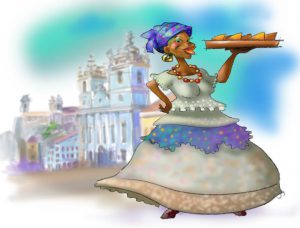
Bahia is the main tourist destination in the Northeast, a cultural melting pot and a great exporter of fads, Bahia boils in the summer.
Bahia has been celebrated in every way by many artists. Its landscapes and mysteries are in the books of Jorge Amado, in the paintings of Carybé, in the songs of Caetano Veloso, Gilberto Gil and Dorival Caymmi. They are also in the drum roll of Olodum and in the roll of Carla Perez.
Where does the magic of this land come from, which invents novelties and imposes its fads on other regions of the country all the time? Bahia is like a chessboard, where anyone can get enough of natural beauty, history, art and bohemia.
All very well mixed, like the races and religions that live there, and served by a cheerful and cordial people, who call any stranger “my king” or “my beautiful”.
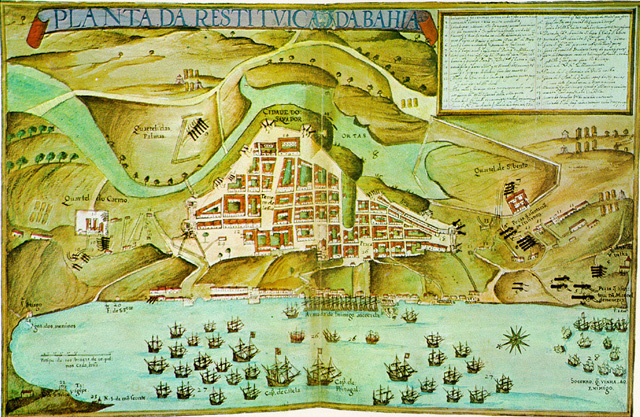
Regiões Turísticas da Bahia
Bahia is a party all year round, but it is in the summer that the vocation for tourism reaches its peak.
In the vacation season, which begins next week and runs until Carnaval – the apex of the Bahian party – about 1.5 million Brazilian and foreign tourists will go to Bahia.
Per year, the total number is around 3.3 million visitors. No wonder. No other Brazilian state has so many and so varied attractions. Its coastline is the longest in the country, with 1,000 kilometers of extension.
There are mangroves, coral reefs, coconut trees, dunes, Atlantic Forest, beaches for all tastes (see some itineraries along the page). Those who do not like the combination of salt water and sand also have their place in the sun. Inland, the waterfalls and caverns of the Chapada Diamantina form one of the most spectacular landscapes in the world.
Discovery Coast – Costa do Descobrimento
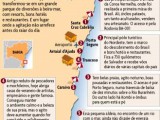
The seduction of Bahia is not, of course, limited to its natural beauty.
Bahia has history. Salvador was the first capital of Brazil and preserves in good condition buildings from the last four centuries. It has a unique cuisine. It has, above all, the Bahian people.
It is they who give life to this state, which would be inviting enough if it only had its coastline and the waterfalls of its chapada.
The Bahian makes his home a place unlike any other. Here, the outsider should not be surprised if, when asking a passer-by for information, he offers to accompany him throughout the tour.
View the map Costa do Descobrimento
Owner of a self-esteem without equal in the rest of the country, for the simple fact of having been born in Bahia, proud of his culture, the Bahian takes pleasure in showing it to the visitor. Wherever he goes, the tourist will be in contact with its rhythms and colors.
Bahian traditions have not been enclosed within four walls, in shows or theme parks for tourists to see and pay for.
The Carnival is a mass phenomenon, not a show for the bleachers and TV, as is the case in Rio de Janeiro’s Sambódromo. Beauty, exoticism, friendliness – it’s all there, genuinely embedded in everyday life. And that’s the big difference.
More affordable travel – For five years now, Bahia has been the most popular tourist destination in the Northeast and the second most popular in Brazil, coming closer and closer to Rio de Janeiro.
With the reduction in airfare prices and the growth of domestic tourism, spending a vacation in good hotels in Bahia is once again cheaper than going to the Caribbean. A seven-night package in Cancún, Mexico, from São Paulo, costs an average of 1,600 reais, including airfare and hotel.
Meanwhile, a package for a similar period and accommodation to Porto Seguro costs 700 reais, less than half. For 1,500 reais, in a slightly more expensive and luxurious option, it is possible to spend a week, in full high season, in two of the best Brazilian resorts, both located in Bahia: the Transamérica of Ilha de Comandatuba and the Praia do Forte.
The price, in this case, includes, in addition to airplane and lodging, breakfast and dinner. “Few Brazilian states take tourism as seriously as Bahia,” says Caio Luiz de Carvalho, president of the Brazilian Tourism Institute, Embratur. The state has become the country’s largest construction site in this area.
In the past seven years, the state government has spent 1.1 billion dollars on tourism-oriented infrastructure, including road construction and renovation of historic monuments.
Another $900 million will be spent by 2005. Private investment is growing at the same pace and should reach 1.7 billion dollars in six years.
Cocoa Coast – Costa do Cacau
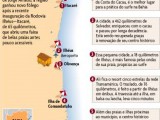
On the eve of its 450th anniversary (in March), Salvador has a new look. The streets and beaches have never been cleaner. Until recently, the city had a reputation for being dirty and smelly.
Today, every morning, water trucks wash sidewalks and stairways along the waterfront, which is being reurbanized in several sections.
Compared to other Brazilian capitals, the sanitation index in Salvador is still quite precarious. Only 38% of homes have sewage.
But this has been improving, thanks to a sanitation project called Bahia Azul, which is cleaning up the beaches and waters of the Baia de Todos os Santos.
In the Praia da Barra, one of the most famous in the capital, where bathing was inappropriate until recently, you can now swim or surf even at night, due to a new lighting of the seafront. Parks and entire neighborhoods have been renovated, turning decaying areas into new tourist spots.
The most exemplary case is the Pelourinho, the largest set of colonial houses from the 17th and 18th centuries in South America.
Considered a UNESCO World Heritage Site in 1985, the neighborhood was in ruins and was one of the largest areas of prostitution in the city. In the last six years, 500 houses in Pelourinho have been restored and now house stores, consulates, restaurants and bars. There are still 300 buildings to be renovated, but the neighborhood is already the city’s main tourist spot and hottest nightlife.
At least during the day, it’s a safe place, with a guard on every corner, where tourists often stroll without the risk of being mugged. These changes have started a virtuous circle of development.
The already renovated places, such as Pelourinho, have a beneficial effect on the surrounding areas. “By improving the city for tourists, we are also improving Bahia for those who live here,” says the state secretary for Culture and Tourism, Paulo Gaudenzi.
Party every day – Those who live in Salvador have adapted their lives to the city’s congested party calendar.
They are countless: lavagens (the most famous of which is Bonfim), blocos rehearsals, largo parties, São João party, Iemanjá party, axé walk (a kind of parade of local artistic movements), pre-Carnival, the so famous Carnival and many others.
Bahia is so festive that residents of neighborhoods that concentrate these celebrations, such as Pituba, Ondina and Campo Grande, have become accustomed to carrying a proof of residence in their pockets: it is the guarantee that they will be allowed to take their cars to the garage if they stumble upon a party at the end of the day. When there is a party – which is almost always – part of the city is closed to cars, a crowd invades the streets and only those who have the voucher can pass with their car.
Coconut Coast – Costa dos Coqueiros
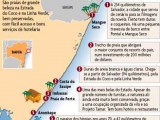
As in all of Brazil, in Bahia there is a deep racial prejudice. It is a prejudice masked by the festivals and manifestations of religious syncretism, which give those who arrive the false impression of a total reconciliation of races and social classes.
Almost all Bahians have some connection with the candomblé, including the prelates of the Catholic hierarchy, who live with Afro rites in the celebrations of their churches.
In Bahia, middle-class whites, artists, politicians, businessmen – and tourists too – go to the candomblé grounds.
View the Costa dos Coqueiros map
The difference between being black in Bahia and in other regions of Brazil is that, there, drumming, dancing, music and other cultural manifestations have served as a strong means of social ascension and are elements that contribute to the black person’s feeling of satisfaction with himself.
As current manifestations of African culture are assimilated throughout the world, even in other states, there is an even greater reinforcement of the pride of race exhibited by many black Bahian groups.
Salvador is home to a large number of NGOs and other civil associations that encourage and defend Bahian culture and African roots.
They take care of everything: from the defense of blacks, gays and so-called minorities to the education of children who go to percussion schools.
Take the case of the Candeal slum. There, every Sunday, middle-class youths jostle with shack dwellers at the rehearsals of the band Timbalada, whose headquarters is known as Candyall Guetho Square. Located in the heart of the favela, the Guetho is the brainchild of Timbalada’s godfather, the performative singer Carlinhos Brown, himself a multicultural product of Bahia.
Thanks to initiatives like this, Bahia is able to produce on an industrial scale rhythms and musical groups that have become the main local product.
This is the case of axé music, the Bahian export-type frevo that yielded musical phenomena such as Daniela Mercury, Ivete Sangalo and Banda Eva. “Bahianity, which was once treated as something poor and pejorative in the south of the country, is now considered a positive thing,” says anthropologist Antonio Risério, author of studies on the subject.
Recôncavo Baiano
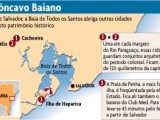
“Here the black man is aware of his African roots, but he has made Bahia his home,” says Italian sociologist Cesare de La Rocca, head of an NGO called Projeto Axé, which cares for poor children.
“He is not melancholic or nostalgic because, unlike blacks in the United States, he does not feel expatriated. He feels like a black Bahian.” African influence, according to scholars, is largely responsible for the Bahian’s celebrated game of cintura.
“It is impossible to understand Bahian culture without knowing the origins of the Africans who arrived there as slaves,” explains historian Luiz Felipe de Alencastro. “The blacks taken to Bahia were different from those who went to other regions of the country.
See the map of Baía de Todos os Santos.
They came from the Gulf of Guinea, while the rest were from Central Africa. In the Gulf of Guinea were the nations with the most complex cultures, because they were neighbors of Islam. The culinary, the rhythms, the dance, the religious manifestations, everything was richer and more creative.”
Dende Coast – Dendê Coast
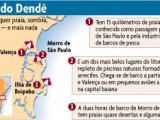
With so many beauties and singularities, it was natural that Bahia should take advantage of its tourist vocation. This change is relatively recent.
Only in recent years have investments been made to transform this landscape, human and cultural capital into an attraction accessible to ordinary tourists.
In June, an airport was inaugurated in Lençóis, which facilitated access to the Chapada Diamantina. In Valença, the main gateway to Tinharé Island, where the trendy village of Morro de São Paulo, an airport and a waterway terminal should be ready by the end of the month.
View the map of the Costa do Dendê
At the beginning of the year, another highway was inaugurated linking Ilhéus to the village of Itacaré, which opened up a strip with another 60 kilometers of beaches until then difficult to access.
Until the end of the 1970s, the beaches of the region of Porto Seguro were still a refuge for hippies who practically rediscovered the place where the Portuguese first landed 500 years ago. Today, the city is a hub with hotels and resorts that welcomed 700,000 tourists last year.
It is the country’s largest mass tourism center. By the end of 1999 the paved highway linking Porto Seguro airport to the village of Trancoso should be ready. There is news elsewhere on the coast.
In Sauípe, a stretch of paradisiacal beaches 80 kilometers north of Salvador, the Odebrecht group is simultaneously building five resorts.
Bahia is so peculiar that even Independence Day is celebrated on a different date. While other Brazilians hold parades on September 7, the Bahians celebrate on July 2.
On that day, in 1823, the Portuguese who still controlled Salvador were finally expelled from the city. “Bahian creativity is present even in its language,” says Nivaldo Lariú, author of the Dicionário de Baianês, with 1,200 entries and 100,000 copies sold.
Does anyone know what it means to “eat water?” In Baianese it means to drink alcoholic beverages. And “brau”? It’s the Bahian equivalent of brega. Everything that is very good is “gold”. And so on. In Bahia, when a friend tells another that he will meet him at 6 o’clock, he means that he will arrive around that time.
For the Bahians, lateness is not a lack of urbanity, but a right, which applies reciprocally. Anyone who has been to a restaurant in Bahia and waited more than an hour between ordering and the arrival of the dish at the table knows what this means. The Bahian has a reputation for being lazy, a characteristic evoked in the songs of Dorival Caymmi.
Like everything in Bahia, this too has its explanation. “Bahians work to live, they don’t live to work as the southern mentality preaches,” says anthropologist Elisete Zanlorenzi, author of a thesis in which she argues that Bahians are not lazy as they say – they just have another way of looking at life and work.
Whale Coast – Costa das Baleias
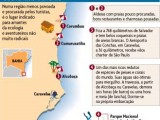
The local codes work in such a way that Bahia manages to achieve a harmony all of its own.
Has anyone ever heard one Bahian speak ill of another? Bahians engage in lively electoral disputes, but they are experts at making chains of solidarity when it comes to promoting another Bahian outside Bahia.
One example: last week saw the launch of a book by Dadá, a Bahian cook who began life in a small restaurant on the outskirts of Salvador, gained local fame and now has trendy branches in Rio de Janeiro and São Paulo.
The presentation of the book, sponsored by the city hall and Bahiatursa (the state tourism company), is by Jorge Amado. The preface is by Paloma Amado, daughter of the writer.
See the map of the Whale Coast.
The drawings, by Carybé, in one of his last works before his death last year. In all, the book quotes and praises almost half a hundred Bahians, unknown and famous – including the publicist Nizan Guanaes, the writer João Ubaldo Ribeiro, the artist Calasans Neto, the recently deceased mother-of-saint Cleusa do Gantois and many others.
It is these peculiarities that make Bahia a kind of parallel universe within Brazil. It is a paradise for tourists.
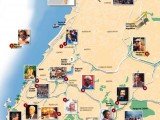
Chapada Diamantina
Divided into four circuits – Chapada Norte, Circuito do Ouro, Circuito do Diamante and Chapada Velha – Chapada Diamantina is one of the most extensive tourist areas in Bahia. Located in the central region of Bahia, the municipalities included in these circuits have their history related to important moments in national life, such as the exploration of the garimpo in the 17th, 18th and 19th centuries.
><nbsp;
View the map Chapada Diamantina
Lagos do São Francisco – São Francisco Lakes
Characterized by the influence of the São Francisco River, this tourist area is formed by the municipalities of Abaré, Casa Nova, Curaçá, Glória, Juazeiro, Paulo Afonso, Remanso, Rodelas, Santa Brígida and Sobradinho, having as main attractions the activities related to fishing and water sports in general.
See the map Lagos de São Francisco
Caminhos do Oeste – West Paths
Located on the left bank of the São Francisco River, this region is composed of the municipalities of Barreiras, Bom Jesus da Lapa, Correntina, Santana, Santa Maria da Vitória, São Félix do Coribe and São Desidério. Considered attractive for its exotic landscapes, this tourist area has shown significant economic growth, driven by significant advances in its agro-industrial segment, notably grain production.
View the map Caminhos do Oeste
Bahia is the main tourist destination in the Northeast




















